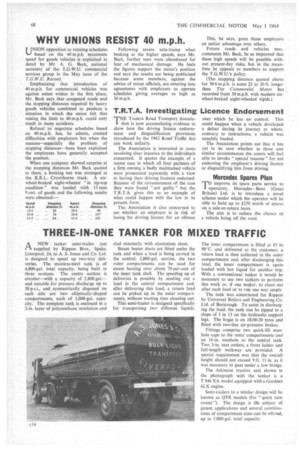WHY UNIONS RESIST 40 m.p.h.
Page 50

If you've noticed an error in this article please click here to report it so we can fix it.
INIONopposition to running schedules based on the 40 m.p.h. maximum speed for goods vehicles is explained in detail by Mr. A. G. Beck, national secretary of the T.G.W.U. commercial services group in the May issue of the T.G.W.U. Record. Emphasizing that introduction of 40 m.p.h. for commercial vehicles was against union wishes in the first place, Mr. Beck says that congested roads and the stopping distances required by heavy goods vehicles combined to produce a situation in which the union felt that raising the limit to 40 m.p.h. could only result in more accidents. Refusal to negotiate schedules based on 40 m.p.h. has, he admits, created difficulties with employers but when the reasons—especially the problem of stopping distances—have been explained the employers have generally accepted the position. When one company showed surprise at the stopping distances Mr. Beck quoted to them, a braking test was arranged at the R.R.L. Crowthorne track. A sixwheel-braked eight-wheeler "in tip-top condition" was loaded with 15 tons 9 cwt. of goods and the following results were obtained:—
Speed Slopping Speed Stopping m.p.h. distame ft. m.p.h dislame fl.
Following severe axle-tramp when braking at the higher speeds, says Mr. w abandoned were aba Beck, further tests oned for fear of mechanical damage. He feels the figures support the union's position and says the results are being publicized because some members, against the advice of union officials, are entering into agreements with employers to operate schedules giving averages as high as 36 m.p.h. This, he says, gives those employers an unfair advantage over others. Future roads and vehicles may. comments Mr. Beck, be so improved that these high speeds will be possible without present-day risks, but in the meantime he appeals to members to support the T.G.W.U.'s policy. (The stopping distance quoted above for 30-6 m.p.h. is some 25 to 30 ft. longer than The Commercial Motor has recorded from 30 m.p.h. with modern sixwheel-braked eight-wheeled rigids.)




















































































































































































































































